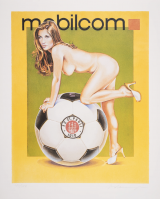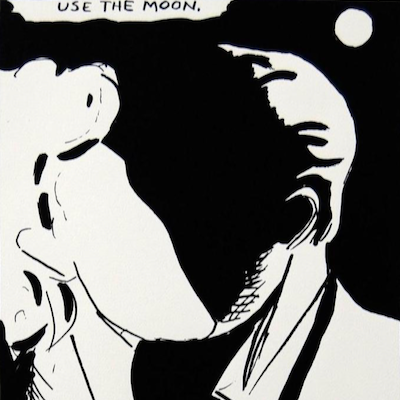
Details
Artist
Styles
Lithograph, signed in pencil - the one we have for sale is a "Pub Proof" (bought from the original publisher) // I Still Get a Thrill When I See Bill I by Mel Ramos, created in 1979, is a lithograph that merges elements of realism and abstraction to create a striking visual effect. The artwork features a partially abstracted female figure, with bold black strokes forming a fragmented body around a realistic, detailed portrait of a woman's face at the top. The juxtaposition of expressive, gestural lines with the carefully rendered face creates a dynamic tension, emphasizing both sensuality and mystery. Ramos’s pop-art influence is evident in the playful yet provocative style, as the artwork explores themes of allure and perception, inviting viewers to interpret the fusion of form and identity.
I Still Get a Thrill When I See Bill I, 1979
form
Medium
Size
72.4 x 53.3 cm
- Inches
- Centimeters
Edition
Price
- USD
- EUR
- GBP
Details
Artist
Styles
Lithograph, signed in pencil - the one we have for sale is a "Pub Proof" (bought from the original publisher) // I Still Get a Thrill When I See Bill I by Mel Ramos, created in 1979, is a lithograph that merges elements of realism and abstraction to create a striking visual effect. The artwork features a partially abstracted female figure, with bold black strokes forming a fragmented body around a realistic, detailed portrait of a woman's face at the top. The juxtaposition of expressive, gestural lines with the carefully rendered face creates a dynamic tension, emphasizing both sensuality and mystery. Ramos’s pop-art influence is evident in the playful yet provocative style, as the artwork explores themes of allure and perception, inviting viewers to interpret the fusion of form and identity.
- Recently Added
- Price (low-high )
- Price (high-low )
- Year (low-high )
- Year (high-low )
What is Comic Strip Art?
Comic strip art refers to artwork that utilizes the subject matter and commercial printing techniques found in comic strips. In the 1960s, a group of artists began creating paintings that incorporated Ben-Day dots—commonly used in comics and advertising—to produce highly graphic designs in bright colors, using traditional art media.




















































